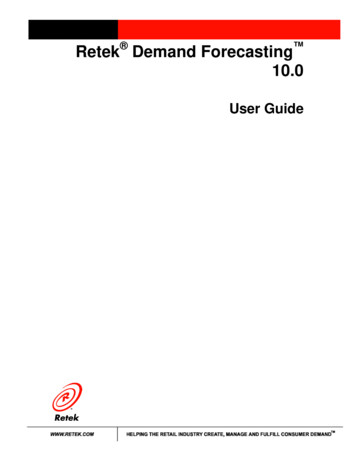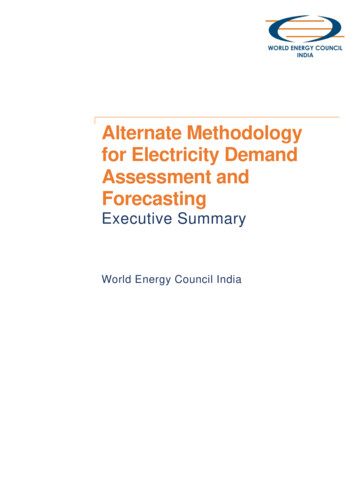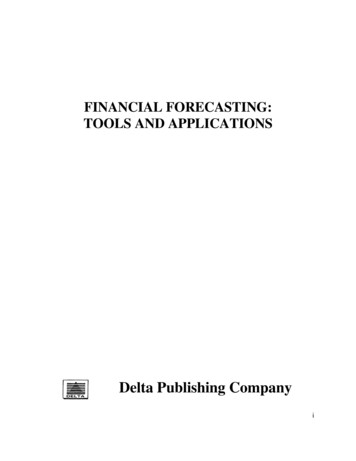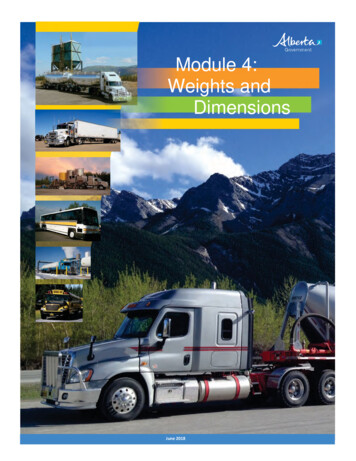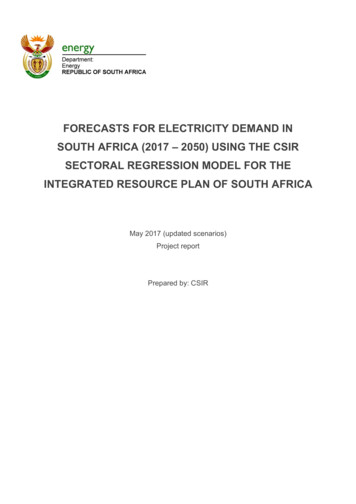
Transcription
FORECASTS FOR ELECTRICITY DEMAND INSOUTH AFRICA (2017 – 2050) USING THE CSIRSECTORAL REGRESSION MODEL FOR THEINTEGRATED RESOURCE PLAN OF SOUTH AFRICAMay 2017 (updated scenarios)Project reportPrepared by: CSIR
Forecasts for electricity demand inSouth Africa (2017 – 2050) using theCSIR sectoral regression modelMay 2017 (updated scenarios)Project reportPrepared for: Eskom(as inputs into the Integrated Resource Plan)Document Reference Number: CSIR/BE/SPS/ER/2017/0013/BCSIR Groupwise DMS: 264844 (Pta General Library)Project team leader: R Koen (012) 841-3045, rkoen@csir.co.zaProject team members: JP Holloway, P Mokilane, S Makhanya, TMagadla, R Koen CSIR 2017 All rights to the intellectual property and/or contents of this document remain vested in theCSIR. This document is issued for the sole purpose for which it is supplied. No part of this publication maybe reproduced, stored in a retrieval system or transmitted, in any form or by means electronic, mechanical,photocopying, recording or otherwise without the express written permission of the CSIR. It may also not belent, resold, hired out or otherwise disposed of by way of trade in any form of binding or cover than that inwhich it is published.1
Table of Contents1.2.Introduction . 3Methodology . 32.1. Data selection and use . 32.1.1. Data on electricity consumption per sector . 32.1.2. Data on losses . 62.1.3. Data on drivers of electricity consumption . 72.2. Regression model selection . 72.3. Adjustments for changes in electricity intensity . 83. Forecasting results. 103.1. Forecasted driver values used . 103.2. Demand forecasts obtained . 164. Final remarks . 205. References . 20List of FiguresFigure 1 Comparing agricultural sector data between different sources . 4Figure 2 Comparing domestic sector data between different sources . 5Figure 3 Comparing commercial and manufacturing sector data between different sources . 5Figure 4 Comparing mining sector data between different sources . 6Figure 5 Comparing transport sector data between different sectors. 6Figure 6 Model fitted for the electricity intensity “correction factor” . 9Figure 7 Values used for electricity intensity ratio (“correction factor”) in scenarios . 16Figure 8 Recommended forecasts for national consumption of electricity using the "CSIRmodel". 18Figure 9 Forecasted values for the 5 electricity sectors . 19List of TablesTable 1 Sources for historical data on “drivers” of electricity consumption. 7Table 2 Summary of regression models used per sector. 8Table 3 Driver forecasts that were the same between different scenarios . 10Table 4 GDP % growth forecasts per scenario . 11Table 5 FCEH % growth forecasts per scenario . 12Table 6 Manufacturing index forecasts per scenario (base year 2010) . 12Table 7 Forecasts for platinum production index (base year 2010) per scenario . 13Table 8 Forecasts for mining production index, excluding gold (base year 2010) . 14Table 9 Forecasts for gold ore treated (million metric tons) . 15Table 10 National electricity demand: CSIR recommended forecasts (including adjustmentsfor electricity intensity changes in the manufacturing sector) . 162
1. IntroductionThe CSIR developed a methodology for forecasting annual national electricity demand incollaboration with BHP Billiton in 2003. This methodology has subsequently been re-used anumber of times, including providing forecasts used in the previous IRP and its revision.A draft set of forecasts were developed using this methodology, by revising the models andapplying the methodology to updated historical data, for producing forecasts for theIRP2015. After the publication of this initial set of forecasts by the Department of Energy,inputs were invited from the public and experts. Based on these inputs, as well as on datafor 2014 and 2015 becoming available during the period after the development of theforecasts and the finalisation of user inputs, updates to the forecasting models and thescenarios underlying the initial forecasts were made. Data for the period 1990 – 2015 wastherefore used to obtain updated scenario forecasts. A fifth scenario, namely “Junk status”was also added to the previous four scenarios. These updated forecasts are presented inthis report.The forecasts, and a brief description of the models used to derive the forecasts, areprovided in this document. However, this document provides only brief references to themodelling approach, and the full methodology is not explained here. For more information onthe methodological aspects and the process of developing the methodology, please refer toprevious IRP reports or to [1].2. MethodologyThe methodology followed to obtain the forecasts presented in this document consisted oftwo parts. The first part consisted of putting together the required historical datasets to useas a basis for the set of forecasting models, and the second part consisted of compiling themodels. Subsection 2.1 discusses the data-related task, while section 2.2 provides details onthe set of forecasting models compiled.2.1.Data selection and useThe data collection tasks involved the collection of electricity consumption data, thebreakdown of this data per electricity usage sector, as well as the collection of data on the“drivers” of electricity consumption. The collection of the various types of data is discussed inthe following sub-subsection, while the use of the “drivers” is explained in subsection 2.2.2.1.1.Data on electricity consumption per sectorData from various sources had already been compared extensively by the CSIR team duringthe development of the methodology and further data comparisons were done during theforecasting for the previous IRP. Since the models developed require the most up-to-datehistorical data available, this round of forecasting again involved doing data collection,derivation and comparisons on the “new” historical data that were collected.Updated data on the electricity usage within the various electricity sectors were collected orderived. The sector breakdowns were checked by comparing the aggregated sector valuesto the national consumption figures published by Statistics SA in its P4141 series onelectricity production volumes and sales, and adjusted where necessary. The sectors usedin this report correspond to the categories used by the National Energy Regulator of SouthAfrica (NERSA) that were also used by the Department of Energy, and reported to the3
International Energy Agency (see [2] for their 2007 statistics on electricity for South Africa,as well as [3] for a list of their data sources).It should be noted that NERSA has not published any data on electricity demand per sectorsince 2006, and the data published by the Department of Energy for their Energy Balancesdatasets did not seem to provide reliable data for the period since 2006. When the CSIRteam compared historical sectoral electricity estimates published in the Energy Balancesdocuments in order to set up a time series of sectoral breakdowns, it was found that valuesin some sectors remained exactly the same over more than one subsequent year, thusindicating data reliability issues. In addition, while Eskom publishes data broken down persector in their Annual reports, sectoral breakdowns are only done for Eskom’s directcustomers. This leaves a large portion of the consumption belonging to the “Redistributor”sector which mainly represents municipalities, who in turn sell electricity to users withindifferent sectors - and therefore this sector needs to be broken down further into sectors.The CSIR team received data from Eskom in which Eskom had done their own sectorbreakdown estimates for internal planning purposes. These estimates were understood tobe based on Eskom customer categories, but adjusted to national consumption in eachsector by breaking down the redistributor component into the other categories usingestimates of Eskom’s share in each category. However, the CSIR team used the Eskomestimates as comparative values only, and we compiled our own estimates of the sectoralbreakdown values from a range of data sources. We also developed a new method toprovide additional verification of the sector breakdowns, which is not discussed in this report(but details could be obtained from the CSIR project team, if required).The graphs in Figures 1 – 5, below, illustrate the comparative values per sector from thevarious data sources, and also show the CSIR estimates (labelled “Recommended”) forsectoral breakdowns in comparison to the values from the other sources.Agricultural Electricity Consumption8000RAU7000NERSA (Unadjusted)6000DME Digest (2002)GWh50004000300020001000DME Digest (1998)DME (Energy Balances)RecommendedEskom's shareEstimate using Eskom %share0Figure 1 Comparing agricultural sector data between different sourcesAlthough the agricultural sector is a small sector, Figure 1 indicates that the various sourcesdiffered quite widely on the pattern of consumption in this sector during the period 1990 –2000, but that the sources were more in agreement since the mid 2000s.4
Domestic Electricity Consumption60000RAU50000NERSA (Unadjusted)DME Digest (2002)GWh40000DME Digest (1998)30000DME (Energy Balances)20000RecommendedEskom share10000Estimate using Eskom %share0Figure 2 Comparing domestic sector data between different sourcesFor the domestic sector, the overall patterns between some sources coincided, but generallythe Eskom sector estimates were usually lower than other sources over the late 2000s. It isassumed that the estimates for this sector are problematic due to the fact that most of thedomestic consumers are supplied with electricity via the municipalities, i.e. they form a largepart of the “redistributors” sector within Eskom sales, and that relatively few domesticcustomers are direct Eskom customers.Commerce Manufacturing General Electricity Consumption160000RAU140000NERSA (Unadjusted)120000DME Digest (2002)GWh100000DME Digest (1998)DME (Energy Balances)80000Stats SA60000Recommended4000020000Eskom's shareEstimate using Eskom %share0Figure 3 Comparing commercial and manufacturing sector data between differentsourcesAlthough most sources provide separate “Commerce” and “Manufacturing” sectors,definitions differ widely between them, and even within different years of the same source.Furthermore, most sources contain a “general” category, and the definition of this category isalso not consistent. However, when data on “commerce”, “manufacturing” and “general”sectors are combined for each of the various sources, the differences between the sourcesare not very substantial, as can be seen from Figure 3, and therefore the CSIR team prefersto combine these sectors into one.5
Figure 4 shows that the various sources do not differ very much in terms of the pattern forthe mining sector. Since Eskom supplies most of this sector directly, in the years wheredifferences occurred, the Eskom values were considered to be the more reliable source andhence the Eskom figures were used.Mining Electricity Consumption40000RAU35000NERSA (Unadjusted)30000DME Digest (2002)GWh25000DME Digest (1998)20000DME (Energy Balances)15000Stats SA10000Recommended5000Eskom's share0Figure 4 Comparing mining sector data between different sourcesFigure 5 indicates quite big differences between sources for the transport sector, but againthis is a fairly small sector.Transport Electricity Consumption7000RAU6000NERSA (Unadjusted)DME Digest (2002)5000GWhDME Digest (1998)4000DME (Energy Balances)3000Stats SARecommended2000Estimate using Eskom %share1000Eskom's share0Figure 5 Comparing transport sector data between different sectors2.1.2.Data on lossesThe various sources consulted by the CSIR differed both in terms of their definition of lossesas well as the way they applied the loss percentages. Some sources “added on” losses afterestimating each sector, while other sources “deducted” the losses in order to adjustestimates downwards. The CSIR team has chosen to apply the loss percentage to theaggregated sectors, i.e. sector forecasts are obtained, aggregated and then losses arecalculated on the aggregated total to obtain the final total.6
The CSIR team also decided to apply one total for losses (i.e., including distribution andtechnical losses) to the combined total for all sectors in order to derive the total nationalconsumption. Data was obtained from Eskom regarding percentage losses recorded, andlosses were also estimated by comparing Eskom data with public domain data. Appropriateforecasts for loss percentages were discussed with Eskom after studying historical patterns.It was decided to fix the loss percentage at 11% for the entire forecasting period. Thispercentage corresponded with historical percentage fluctuations and, in discussion withEskom staff, it was agreed that this value would be an estimate that would balanceexpansion of the transmission grid (i.e. increasing transmission losses) with changes ingeneration patterns (which may reduce other types of losses) over the medium to long term.2.1.3.Data on drivers of electricity consumptionFor data on potential “drivers” of electricity, historical data were obtained from the SouthAfrican Reserve Bank, Chamber of Mines and Statistics SA.Table 1 Sources for historical data on “drivers” of electricity consumption“Driver” dataSourceGross Domestic Product (GDP)Final Consumption Expenditure of Households (FCEH), alsocalled Private Consumption Expenditure (PCE) in somesourcesIndex for Manufacturing production volumesIndex for Mining production volumes (gold, coal, iron ore,PGM and total index (including and excluding gold))PopulationNumber of households and average household sizeGold ore milled and gold ore treatedReserve Bank of South AfricaReserve Bank of South AfricaStatistics SA (Statistical releases)Statistics SA (Statistical releases)Statistics SA (Midyear estimates)Statistics SA (General PopulationSurvey)Chamber of Mines2.2. Regression model selectionThe methodology followed was to analyse data on electricity consumption as well as onaspects that describe general demographic and economic conditions which couldconceivably influence consumption. Multiple regression modelling was chosen as thetechnique to be used for forecasting the annual consumption within the individual electricitysectors by relating such influencing aspects (or “drivers”) to the demand in each sector.The development of models for the different electricity consumption sectors involvedidentifying a large set of measures that could be considered as possible / potential predictorsfor each sector, followed by regression modelling to determine the best forecasting modelsfor the consumption in each sector that could be obtained from this set. The modellinginvolved an iterative process of fitting a model, assessing it, making changes, rerunning andcomparing the model to the one(s) before the changes.The “best” models were chosen from this iterative process to be statistically sound, to be assimple as possible (i.e. have as few “drivers” as possible), and to satisfy a logicalunderstanding of the sector being forecasted. To know whether a model was statisticallysound it had to show a good fit to the historical data, to have low levels of multi-collinearityand to show acceptable residual patterns. Model fit can be measured in various ways, but inthis study the adjusted R2 value was used. The closer the adjusted R2 is to 1, the better themodel fit. However, even models that fit the historical data well could suffer from high levelsof multi-collinearity, so model fit alone is not sufficient. Multi-collinearity is the statistical termto indicate that the “drivers” included in the model are related to each other, and this can be7
a problem in a model intended for forecasting. Models therefore had to have low levels ofmulti-collinearity to be considered acceptable. The levels of multi-collinearity of a regressionmodel can be measured by the condition index (in this study the so-called singular-valuedecomposition condition index, with the centering option, as discussed on pp 337 – 341 in[4], was used) and the value of the condition index should be below 30 to ensure low levelsof multi-collinearity.The CSIR team believes that the models derived for each sector fitted the collected historicaldata well and were also appropriate for forecasting future demand. Table 2 summarises therevised models (i.e., the group of CSIR models) used for each of the sectors’ forecasts.Data about the statistical fit of the models (as indicated by the adjusted R2), as well as theamount of multi-collinearity present in the model (as measured by the condition index), aregiven for each model.Table 2 Summary of regression models used per sectorElectricitysectorModel used(Note: the “predictor variables”indicated in bold in each model)Adjusted RAgriculture-42238 3356.46 ln(FCEH)Adjusted R 0.96Transport1612.11 37.29 mining index excluding goldAdjusted R 0.65-380485 29725 ln(FCEH)Adjusted R 0.97DomesticMining222NOTE: The intercept value was adjusted to align the startingpoint of the forecasts (for 2015) with the observed actualvalues for 2015)-69653 2577.51 population 572.0 manufacturing index correction factorCommerce &manufacturing2ConditionindexN/A if only 1variable inmodelN/A if only 1variable inmodelN/A if only 1variable inmodel2CI 23.92CI 26.3Adjusted R 0.96NOTE: The “correction factor” adjusts for electricity intensity asexplained in section 2.3 The intercept value was adjusted to align the startingpoint of the forecasts (for 2015) with the observed actualvalues for 201524454 49.094 platinum index 0.053 gold oretreatedAdjusted R 0.69Note that although CSIR was requested to use two different models in the commerce andmanufacturing sector, one with and without the “correction factor”, the model fitted withoutthe correction factors was not considered to be as good as the one with the “correctionfactor”, and therefore only one model was developed. The “correction factor” was modelledhistorically as explained in the next subsection, and used in the forecasts as explained insection 3.1.2.3. Adjustments for changes in electricity intensityThe CSIR team has in the past (i.e. previously when a set of forecasts for electricity demandwas developed) used the historical data as the main basis for developing forecasting modelswithout adjusting either the historical data or the forecasts. The assumption has been thatany changes with regard to electricity usage, such as responses to higher electricity prices,energy saving initiatives, and so on, would be recorded as part of the historical data, andtherefore implicitly be factored into the models. However, for the previous revision of theIRP forecasts, a need was identified to add an explicit aspect regarding electricity intensityinto the models for the manufacturing sector and not to rely only on the implicit incorporation8
of it based on historical patterns. This was considered necessary in order to provide a wayto model future scenarios that contrast expansion of electricity intensive sectors of theeconomy with the development of less energy intensive sectors in order to achieveeconomic growth. Therefore, the suggested scenario descriptions require that the futurepatterns of electricity intensity would differ from its historical patterns. In this new IRPforecast it was decided to continue this precedent, since there was again one scenario thatinvolved the expansion of less energy intensive sectors.The way in which electricity intensity was added to the models was by incorporating a“correction factor” representing the ratio between electricity used and goods produced within,specifically, the manufacturing sector.Data on electricity usage within the manufacturing and commercial sector was taken fromthe Eskom estimates, and the ratio between this electricity usage and the index ofmanufacturing volumes (as obtained from Statistics SA) was calculated and plotted asindicated in Figure 6. The figure indicates the declining pattern for the period 2009 - 2015with the green line, and a logarithmic function fitted to the historical data pattern to representthe overall trend in this ratio as a black line. When the ratio decreases, then it indicates thatless electricity was required to produce the same volume of goods, and when it increasesthen more electricity was used in order to produce similar volumes of goods. The estimated“correction factor” values, obtained from the polynomial curve, were used to represent aproxy for the historical trend in the electricity intensity in the manufacturing sector.The “correction factor” was multiplied with the manufacturing index and this combinedvariable was incorporated into the model (see Table 2 in section 2.2). In this way, the“correction factor” was used to adjust, or “correct”, the effect that the manufacturing indexhad on the electricity usage and therefore bring in some way of modelling the fact that lesselectricity seemed to have been used per unit produced.Logarithmic function fitted to the historical relationship between electricityin Eskom's commerce & manufacturing sector and the manufacturingvolume index1.501.401.301.201.101.000.90y -0.075ln(x) 0.9652R² 0.57280.800.700.600.50Figure 6 Model fitted for the electricity intensity “correction factor”9
3. Forecasting resultsThis section provides the revised forecasts, namely demand forecasts for nationalconsumption of electricity for the period 2016 – 2050.3.1. Forecasted driver values usedIn the IRP, five growth scenarios were specified for use in forecasting, namely the “High(Same sectors)”, “High (Less energy intensive)”, “Moderate”, “Low” and “Junk status”scenarios. Expected values for the different driver variables were linked to each scenario.These scenarios represent the mechanism for introducing uncertainty regarding the futurevalues of the drivers into the electricity forecasts. Differences between the scenarios werequantified in terms of economic variables, namely values for the expected GDP, theexpected Final Consumption Expenditure of Households (FCEH), as well as the relevantmanufacturing and mining indexes. For some drivers, namely population size and thepercentage losses, only one set of forecasts were used throughout all the scenarios. Themodels were used by inserting the expected future values for each of the “driver” variablesinto the relevant sectoral models in order to obtain a forecast for each sector. The sectoralforecasts were aggregated and then adjusted for losses in order to obtain a forecast fornational consumption. Note that, as explained in subsection 2.1.2, a fixed value of 11% wastaken as the loss percentage across all scenarios, but that this percentage was “phased in”from the lower values observed over the 2010 to 2015 period.The following six tables summarise the “driver” values used for the forecasts. The first table(Table 3) provides the driver values that did not change between scenarios, while the nextthree (Table 4, Table 5 and Table 6) provide the growth percentages on the macro economicvariables that differed between the scenarios. Table 4 provides GDP scenario values, Table5 provides FCEH scenario values and Table 6 provides scenario forecasts for theManufacturing Index. Tables 7, 8 and 9 provide the scenario forecasts for the measuresrelated to the mining industry. Note that the annual data is provided as per calendar year,not per financial year, in all tables.Table 3 Driver forecasts that were the same between different scenariosPopulation (inLine losses (% ofYearmillions)sectoral 63.261110
462047204820492050Population 80%1.80%1.80%1.80%1.80%1.80%Line losses (% ofsectoral total)11111111111111111111111111111111Table 4 GDP % growth forecasts per scenarioModerateHigh (Less energyHigh 20%3.20%2.50%3.00%3.00%2.50%3.00%3.00%Junk %3.00%3.00%11
2.42%2.41%2.40%2.39%High (Less energyintensive)3.00%3.00%3.00%High (Samesectors)3.00%3.00%3.00%Table 5 FCEH % growth forecasts per scenarioModerateHigh (Less energyHigh 46%2.97%3.19%3.45%2.97%3.19%3.56%Junk status3.00%3.00%3.00%Junk %3.69%3.69%3.68%3.73%3.71%Table 6 Manufacturing index forecasts per scenario (base year 2010)YearLowModerateHigh (Less energyHigh (SameJunk 7.93127.52126.29137.75107.6412
0274.18279.66High (Less 4.29218.58222.95226.96231.05235.21High 1343.83354.14364.06374.25383.98Junk 167.74170.76173.49176.27Table 7 Forecasts for platinum production index (base year 2010) per scenarioYearLowModerateHigh (Less energyHigh (SameJunk .276107.66131.3897.9
International Energy Agency (see [2] for their 2007 statistics on electricity for South Africa, as well as [3] for a list of their data sources). RAU It should be noted that NERSA has not published any data on electricity demand per sector since 2006, and the data published by the Department of Energy for their Energy Balances

